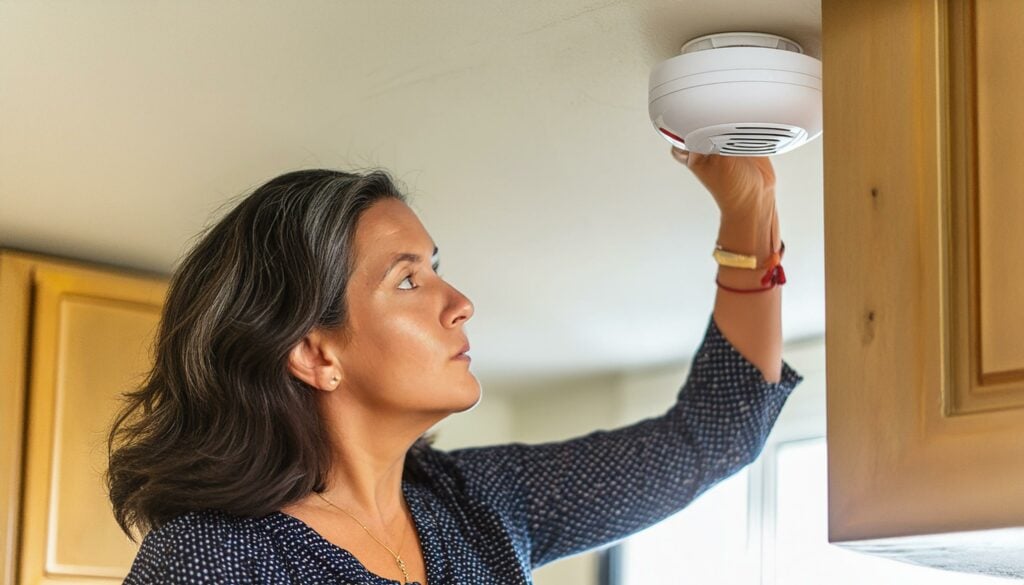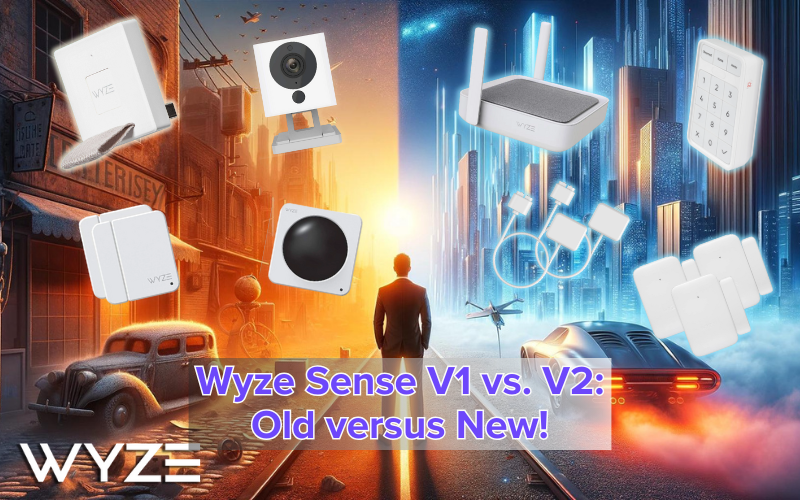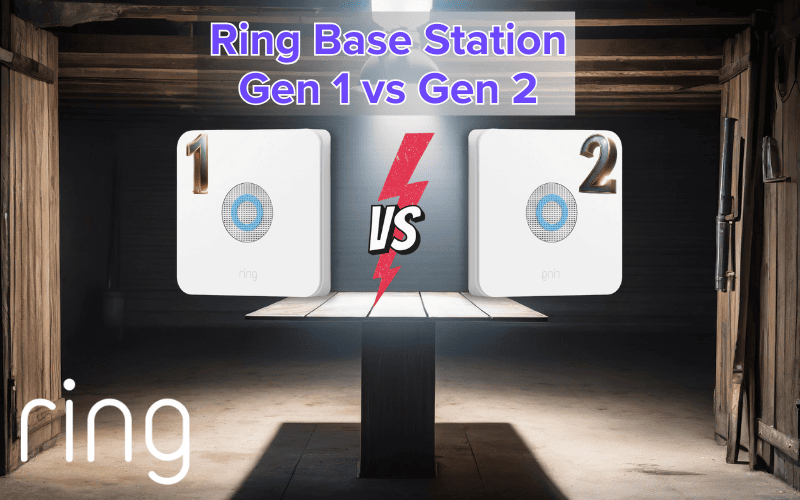SimpliSafe offers one of the modern home’s most intuitive domestic alarm systems. This success can be attributed to the many SimpliSafe sensors, which seamlessly merge into one of the most foolproof security systems any homeowner could ever request.
Three stand out among the sensors that make SimpliSafe such a great brand: Entry Sensors, Motion Sensors, and Glass Break Sensors. This article discusses these three sensors, providing information on what each is used for, how they work, their key similarities and differences, and when to choose one.

Meet the Devices
SimpliSafe Entry Sensor at a Glance
The SimpliSafe Entry Sensor is designed to let you know when a door (or window) is opened.
These entry sensors are two-piece devices that sense when a door is opened or closed by how far apart the two different parts of the device are from each other. When the two parts of the device are within 2 inches of each other, the sensor indicates that the door (or window is closed). When farther than 2 inches apart, it records as open.
SimpliSafe Motion Sensor at a Glance
The SimpliSafe Motion Sensor is designed to detect and alert you when the sensor picks up on motion within the sensor’s field of view (FOV).
These sensors don’t just pick up on any motion, however. SimpliSafe has designed its sensor to detect people and ignore things like pets. This leaves you with a motion detector you can trust not to trigger a false alarm every time your cat walks into its FOV.
Note: While SimpliSafe’s motion detection algorithm is one of the smarter ones in the market and is designed to distinguish between humans and pets, pets can sometimes still trigger the sensor when they come too close.
SimpliSafe Glass Break Sensor at a Glance
The SimpliSafe Glass Break Sensor is designed to do exactly what its name suggests: to detect when glass is broken or shattered, triggering an alarm whenever that happens. This device is intended to be installed close to windows, glass doors, and other glass-covered entryways.
Key Differences
The SimpliSafe Entry Sensors, Motion Sensors, and Glass Break Sensors are three devices designed to meet three different purposes. As such, each one has quite a few differences. Below are the significant differences between them.
Product Design
Because each of these devices was designed to meet different needs, they each feature uniquely different designs.
The Entry Sensor is a relatively small two-piece device designed to be installed behind doors and windows. It is the only two-piece device of the three sensors discussed here.
The two parts of this sensor aren’t equal; one half (which holds the battery and the significant components of the sensor) is much larger than the other half. These two halves need to be present and installed on the door or window correctly to function properly.
On the other hand, the Motion Sensor is a slightly larger one-piece device shaped like a small box with a dome-like fixture embedded on the front of the device. This small dome-like part of the device houses the device sensors and is what detects motion.
The Glass Break Sensor is similar to the Motion Sensor but has one significant difference. Where the Motion Sensor features a dome-like feature on one side, the Glass Break Sensor features a hole that houses the microphones with which the sensor detects the sound of broken glass.
How they Work
SimpliSafe Entry Sensors, Motion Sensors, and Glass Break Sensors are three different devices that work by employing three different technologies;
- Entry Sensors use magnets to detect when a door is open or closed.
When an entry sensor is installed on a door or window, the larger half is installed on the door or window, and the smaller one is installed on the frame.
They are both to be installed so that when the door or window is closed, both halves should be no farther than 2 inches apart. When the sensor’s magnet detects that both halves are within two inches of each other, the sensor determines that the door is closed.
However, suppose the two halves become more than 2 inches apart. In that case, the sensor determines that the door has been opened and alerts you.
- Motion Sensors use passive infrared PIR detection technology.
SimpliSafe Motion Sensors use passive infrared (PIR) technology to detect changes in heat patterns within a region. These devices contain PIR sensors that sense heat. They are then paired with advanced pattern recognition algorithms that allow them to recognize human shapes.
This lets these sensors recognize motion and identify distinct human-like motion. Because of this feature, your SimpliSafe Motion Sensor can distinguish between an intruder sneaking around your home and your pet playing around at night, reducing the possibility of triggering a false alarm.
- Glass Break Sensors use sound to identify glass-breaking
SimpliSafe Glass Break Sensors have inbuilt microphones that detect changes in sound in a given area. The sensor then uses sound comparison algorithms to compare any changes in the sound pattern to several known audio patterns created when glass breaks. When similar sounds are detected, the sensor alerts you that a glass break has occurred within the area.
Installation
The three devices have different modes of installation, so they function correctly.
The Entry Sensors need to be installed on a door or window, with the two parts adequately aligned and no more than 2 inches away from each other (when the door is closed).
The Glass Break Sensor should be installed anywhere there are glass windows, doors, or other glass bodies that can be broken into. Preferably, the sensor should be close to the glass and in a direct line of sight to it.
That said, you should avoid installing your sensor close to sources of noise or loud sounds, such as TVs and speakers.
Motion Sensors, on the other hand, can be installed anywhere. As long as the sensor is installed in a position where individuals can come within its effective detection range and fall within its 90° field of vision, it will be able to detect motion.
While you can install the motion sensor anywhere, SimpliSafe recommends installing it about 6 feet off the ground. This greatly reduces the chances of the detector being triggered by pets walking around.
Detection Range
The SimpliSafe Motion Sensor has the best detection range of the three devices. With up to 45 ft of motion detection range and a 90° wide field of vision, the motion sensor has the best range.
Following the Motion Sensor, the Glass Break Sensor has a 20-foot range. Unlike the motion sensor, which can only detect motion in front of it, the glass break sensor can detect the sound of glass breaking at a 360° angle.
On the other hand, the Entry Sensor has no range and can only detect when the door or window it is installed on is opened or closed. Nothing more.
Adjustability and Versatility
Of the three devices, only the SimpliSafe Motion Sensor can have its sensitivity and range adjusted.
With this sensor, you can adjust the range from 45 ft maximum to 30 ft or 15 ft.
You can also adjust the sensitivity from High to Medium or Low.
The other two sensors don’t have that level of freedom, making the motion sensor the most versatile of the three.
Susceptibility to False Alarms
No security system is without flaws, and while SimpliSafe sensors are pretty reliable, they, too, are prone to the occasional false alarm.
However, the entry sensor is the most reliable of the three sensors being discussed in this article.
Unlike the motion sensor, which can sometimes be triggered by pets or even other heat sources like a light bulb, or the glass break sensor, which sounds from the TV can set off, you can rest assured that, unless there is some sort of fault with your device, internet connection, or the SimpliSafe server itself, your entry sensor will only be triggered when your door/window is opened or closed.
Required Number of Sensors for Effective Monitoring
The most effective alarm system uses all three of these sensors. If you choose one type of sensor, however, you’d require more than one sensor to effectively monitor your home.
If you choose entry sensors, you’d need one on at least every door and window that leads into your home.
If you choose motion sensors, you’d need one sensor in every major passage (including staircases) an intruder would have to go through when they enter your home.
Pro Tip: You might also want to strategically place one motion sensor in critical blindspots that your cameras don’t cover (if you have cameras installed).
If you choose glass break sensors, you’d need at least one sensor in every room with a glass window, door, or skylight that can be broken into. Remember that the sensors should be within 20 feet of the glass and perform best when in direct line of sight of the glass.
Price
The three sensors being discussed in this article come with different price tags;
- SimpliSafe Entry Sensors Retail for less than $15.
- SimpliSafe Motion Sensors Retail for about $30.
- SimpliSafe Glass Break Sensors Retail for less than $40.
Similarities
Despite the differences between the three sensors, there are still quite a few similarities.
Effective Range from SimpliSafe Base Station
To function correctly, the SimpliSafe Motion, Entry, and Glass Break Sensors must connect to a SimpliSafe Base Station. All sensors must be within 400 feet of the base station.
Pro Tip: This range can be reduced by things like walls, large pieces of furniture, and electromagnetic interference from other wireless devices. For this reason, your actual base station range might be closer to 300 feet or less. We recommend testing your effective connectivity range before installing any of your sensors.
Mobile App Support
The SimpliSafe Mobile App can monitor and control the entire SimpliSafe Alarm System, including all the SimpliSafe Sensors. This means you can arm, disarm, monitor, and even change the sensor’s settings anywhere in the world with the SimpliSafe Mobile App.
Alerts
All SimpliSafe sensors provide real-time alert features that ensure you always get notifications whenever your armed sensors detect any changes.
Note: It is possible to turn off these alerts on the SimpliSafe App if you don’t want them.
Our Take: SimpliSafe Entry Sensor vs. Motion Sensor vs. Glass Break
The three sensors listed above are excellent choices for any home. Used together, these three provide a foolproof alarm system you can bank on to keep your home safe from intruders. However, if you can’t afford to purchase all three types of sensors, here’s a quick guide on choosing which ones to choose.
Select Simplisafe Entry Sensor if You Have No Other Sensor
In our opinion, entry sensors are the most basic sensors every home needs. So, if you are looking to get your first sensor, this is the way to go.
Entry sensors are also a great choice if you have little money. They are the cheapest of the three sensors, so they’re the best choice when you want to spend less.
Select Simplisafe Motion Sensor if You Want to Monitor Open Spaces
Motion Sensors are the best in open spaces like rooms or passages. They are especially great for staircases or hallways with no doors or windows that can be monitored with the other sensors.
Select Simplisafe Glass Break Sensor if You Want Additional Protection
The SimpliSafe Glass Break Sensor helps cover the blind spots of the other sensors above, especially that of the entry sensor. Since the entry sensors only trigger an alarm when someone opens your door or window, the sensor wouldn’t be triggered if a burglar breaks your window and gets into your home without actually opening the window. A glass break sensor would come in handy here.


